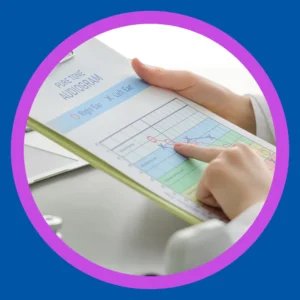How Do You Get a Free Hearing Test in Sioux Falls?
If you’re searching for a free hearing test in Sioux Falls, Stanford Hearing offers comprehensive evaluations at no cost. We believe your hearing health matters. Early diagnosis can protect your well-being, and screening is the first step toward clarity. Let’s explain everything you need to know about testing, treatment options, and how to schedule your appointment easily.
Hearing isn’t just about ears. It impacts your relationships, brain health, and overall quality of life. That’s why nothing is more important than regular testing by a qualified hearing care provider.
Why Should You Prioritize a Free Hearing Test?
Many people delay hearing testing until communication problems significantly impact life. In truth, early detection offers major benefits.
- Hearing declines slowly. Most people do not notice subtle changes until loss is moderate.
- Mental health risks grow. Hearing loss has links to depression, anxiety, and cognitive decline.
- Testing is painless and fast. Free screenings with certified professionals can offer great peace of mind.
- Early treatment helps the brain adjust faster to hearing changes and device use.
- Symptoms may indicate other health issues, like high blood pressure or diabetes.
A well-known public health study shows hearing loss significantly raises risk of cognitive decline. Adults with moderate hearing loss were three times more likely to develop dementia. Severe loss raises this risk to five times the normal rate. Learn more about the science in this study linking hearing loss and dementia.

Who Should Schedule a Free Hearing Test?
Everyone can benefit from a hearing test. But these groups should prioritize a screening:
- Adults over 50 — every 2–3 years
- Adults over 60 — at least annually
- People in noisy environments — such as construction, music venues, or factories
- Anyone with ringing in the ears (tinnitus)
- Those turning up the TV or asking for repeats
- People with balance issues or dizziness
- Individuals with diabetes, high blood pressure, or cardiovascular disease
- Parents of children with speech delays or inconsistent responses to sounds
Hearing decline can start early. Don’t wait until symptoms are obvious. Regular screening keeps you ahead of changes.
What Is a Hearing Test at Stanford Hearing?
A hearing test, or audiometry, measures how well you detect and comprehend different sounds. Stanford Hearing in Sioux Falls provides a full hearing evaluation tailored to you. The goal: identify any hearing loss that might affect communication or daily life.
Testing includes:
- Pure-tone audiometry
- Speech recognition evaluation
- Bone conduction testing
- Tympanometry
- Otoacoustic emissions (OAE)
- Auditory brainstem response (ABR)
These tests are easy, safe, and reliable. No special preparation required. Total appointment time is typically under 60 minutes.
What to Expect During Your Free Hearing Evaluation
We designed the process to be stress-free and informative from start to finish.
1. Welcome & Consultation
You’ll meet with a certified hearing care provider. They’ll ask about your hearing history, noise exposure, and current concerns. This tailored approach helps us select the right tests for you.
2. Ear Visual Exam
We inspect your ear canals with an otoscope. We identify any earwax, infection, or structural issues that might affect hearing. These can often be treated right away.
3. Pure-Tone Audiometry
You’ll wear headphones and signal when you hear a series of tones. This measures your sensitivity to different pitches and volumes and builds your audiogram.
4. Speech Recognition
Words are played through headphones at varying volumes and background noise. You repeat what you hear. This test measures how well you understand speech, not just hear it.
5. Bone Conduction Test
A small vibrator is placed behind one ear to test the inner ear’s function without outer or middle ear involvement.
6. Tympanometry
A probe alters air pressure in the ear to evaluate eardrum movement and middle ear health. Irregular results may indicate fluid, perforations, or stiffness.
7. Otoacoustic Emissions (OAE)
A probe sends sounds into the ear and records emissions created by the inner ear’s hair cells. This helps evaluate cochlear function.
8. Auditory Brainstem Response (ABR)
For select cases, we measure how your brainstem responds to sound. Small sensors capture neural activity to help identify neurological or developmental issues.
Find out how fireworks may cause hearing damage.

Understanding Your Audiogram
An audiogram visualizes your hearing sensitivity across frequencies. You’ll see precise information such as:
- Softest tones you can detect
- Which frequencies are affected
- Differences between ears
- Type of hearing loss (conductive, sensorineural, or mixed)
Your provider immediately reviews results. We talk through next steps, whether treatment or further tests are suggested.
Why Choose Stanford Hearing for a Free Hearing Test?
We stand out because we combine quality care with compassion and convenience.
- Always free for new patients
- Friendly, experienced hearing care providers
- Full diagnostic capabilities
- Immediate explanation of results
- On-site hearing aid fitting
- Access to top manufacturers
- Ongoing support and follow-up sessions
Our hearing care providers never just leave you with results. We explain your ears, your needs, and guide you toward sound solutions.
How Often Should You Get Checked?
Hearing changes gradually. Regular screening is key to early detection.
Follow this plan:
- Under 50, no risk factors: every 3–5 years
- Age 50–60: every 2–3 years
- Over 60 or at risk: annually
- Anyone with ongoing symptoms: schedule testing right away
Professionals in noisy workplaces also need yearly evaluations.
What Happens If You Do Have Hearing Loss?
After your free test, we’ll discuss findings clearly. We’ll explain the type, severity, and what it means to your life. Then we’ll recommend:
- Wax removal or infection treatment
- Prescription hearing aids
- Assistive listening devices
- Referrals to an ENT or specialist if needed
- Guidance on protecting remaining hearing
We partner with you to create a personalized care plan that fits your preferences and lifestyle.
What Are the Latest Hearing Aid Features?
Hearing aid technology has advanced greatly. Modern devices offer features that enhance your experience daily.
At Stanford Hearing, we carry:
- Discreet in-ear (ITE) designs
- Receiver-in-canal (RIC) for enhanced sound quality
- Behind-the-ear (BTE) models for all types of hearing loss
- Bluetooth connectivity for call and music streaming
- Rechargeable battery options
- Health features like fall detection and activity tracking
We demo devices so you can compare comfort, sound, and ease of use before deciding.
The Life-Changing Benefits of Hearing Care
Untreated hearing loss can impact physical and emotional wellbeing. Early treatment supports improved outcomes.
When hearing is well-managed you can:
- Connect better with friends and family
- Improve confidence and independence
- Reduce mental strain and fatigue
- Stay alert and safe
- Reduce fall risks
- Boost mental sharpness
- Live a more social, happy life
Hearing health is life health—do not underestimate the difference it can make.
Signs You Shouldn’t Delay Testing
Sometimes hearing loss is subtle but can still hold you back. Get tested if you notice:
- Difficulty following conversations
- Frequent requests for repeats
- Turning up the volume often
- Ringing, buzzing, or pressure in ears
- Dizziness or balance problems
- Missing phone calls or alerts
- Family members expressing concern
If any of these feel familiar—don’t wait. Early care is easier and more effective.
Find out if Viagra causes hearing loss.

Hearing and Overall Well-Being
Hearing health affects more than communication. It influences mental sharpness, emotional balance, and physical safety.
- Cognitive decline increases with untreated hearing problems
- Risk of social isolation, anxiety, and depression rises
- Mental strain weakens memory and focus
- Increased fall risk relates to both hearing and balance
- Untreated conditions may signal broader health issues
Your ears are connected to your whole body—prioritizing them preserves your life.
How to Book Your Free Hearing Test
Ready to take the next step? Here’s how:
- Visit our contact page
- Request a “free hearing test” appointment
- Choose a time that suits your schedule
- Arrive a few minutes early to complete intake forms
- Enjoy a personalized, pressure-free evaluation
All you need is your basic health info. We handle the rest.
Hear Better, Live Better
A simple, free hearing test can be a turning point. If you live in Sioux Falls or nearby, don’t put it off. Stanford Hearing is ready to guide you with expert care, detailed testing, and clear next steps.
Schedule your free hearing test now.
Protect your hearing, maintain your lifestyle, and preserve your mental clarity. You deserve the world—but only if you can hear it.
Frequently Asked Questions
Is the free hearing test really free?
Yes. At Stanford Hearing, a complete diagnostic hearing evaluation for new patients is provided at no cost.
How long does the test take?
Plan for about 45 to 60 minutes, including consultation and testing.
Do I need insurance?
No. You can receive a free hearing test even without insurance.
Discover more about hearing aid insurance benefits.
Will there be pressure to buy a hearing aid?
Absolutely not. Our priority is your health. Recommendations come only when needed, never pushed.
Can I bring someone with me?
Yes! Spouses and family members are welcome and often find value in attending.
What if my child has hearing concerns?
We test all ages. Early assessment protects speech, learning, and development.
